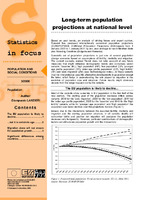Statistics in Focus: Population and social conditions. Long-term population projections at national level.

Working Document
Συγγραφέας
EU Commission
Ημερομηνία
2006-02-03Προβολή/
Θεματικές επικεφαλίδες
Statistics ; Social policy ; Social Europe ; DemographicsΠερίληψη
Based on past trends, an analysis of driving forces and expert opinion, Eurostat has produced internationally consistent population projections (EUROPOP2004: EUROstat POpulation Projections 2004-based) from 1 January 2005 to 1 January 2051 by sex, year and age for each Member State plus Acceding Countries (Bulgaria and Romania). Eurostat’s set of population projections is just one of several population change scenarios based on assumptions of fertility, mortality and migration.
The current scenario, named Trend, does not take account of any future measures that might influence demographic trends and comprises seven variants: ‘baseline’ (BL), 'high population' (HP), 'low population' (LP), ‘younger age profile population’ (YP), ‘older age profile population’ (OP), ‘high fertility’ (HF) and 'zero migration' (ZM) (see methodological notes). All these variants must be interpreted as possible alternative developments in population except the latter, which helps in understanding the role played by migration in the evolution of population size and structure. Future results might obviously deviate from the range mapped out by the variants.
